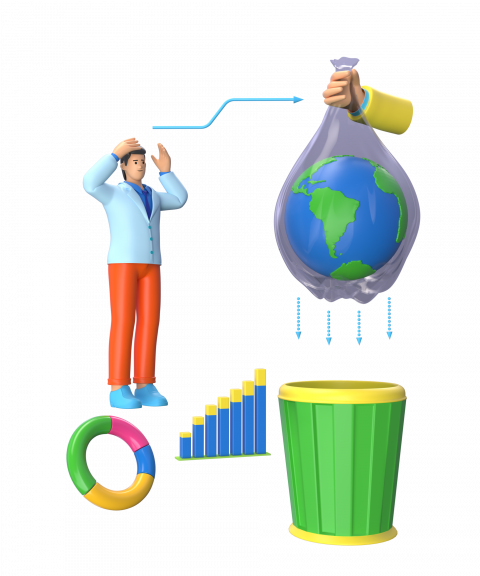Plastic water bottle, especially those made of certain plastics, have raised concerns about their potential effects on human health, including hormone disruption Chemicals such as bisphenol-A (BPA), phthalates and others in plastic bottles are the main concern. Here’s how plastic water bottles, especially those containing BPA, can affect the Human Body and on Female Hormones.
Bottle are used in our daily lives and come in various forms, each with unique characteristics and uses. Here are some common plastic bags used in everyday life.
Polyethylene Terephthalate (PET) Bottles: PET bottles are
among the maximum common plastic bottles used for liquids like water, soda,
juice, and sports activities drinks. They are light-weight, transparent, and
recyclable.
High-Density Polyethylene (HDPE) Bottles: HDPE bottles are recognized for his
or her sturdiness and resistance to chemicals. They are regularly used for
merchandise inclusive of milk, detergents, shampoo, and motor oil.
Low-Density Polyethylene (LDPE) Bottles: LDPE bottles are flexible and
squeezable. They are commonly used for merchandise like condiments (ketchup,
mustard), toiletries (shampoo, conditioner), and some styles of food packaging.
Polypropylene (PP) Bottles: PP bottles are rigid and heat-resistant. They are
frequently used for merchandise that need to face up to better temperatures,
such as hot sauces and microwaveable food boxes.
Polycarbonate (PC) Bottles: Polycarbonate bottles, although much less not
unusual these days, had been as soon as used for objects like infant bottles
and sports water bottles. They are recognised for his or her durability but
have raised concerns about Bisphenol-A (BPA) exposure.
Polyvinyl Chloride (PVC) Bottles: PVC bottles are not as not unusual as
different types because of worries approximately chemical leaching. They are
used for some non-public care products and cleansing solutions.
Polystyrene (PS) Bottles: Polystyrene bottles are light-weight and used for
products such as cleansing components, cosmetics, and a few meals objects.
However, they are much less not unusual than PET or HDPE bottles.
Polyethylene Naphthalate (PEN) Bottles: PEN bottles are a variation of PET
bottles and are used for sure beverages and condiments. They provide improved
gasoline barrier houses.
Acrylonitrile Butadiene Styrene (ABS) Bottles: ABS bottles are tough and
effect-resistant, making them suitable for products like some non-public care
items and automotive products.
Polyethylene (PE) Squeeze Bottles: These bottles are frequently used for
allotting sauces, dressings, and condiments in eating places and households.
They are designed for easy squeezing.
Plastic Spray Bottles: These bottles have a trigger spray mechanism and are
typically used for family cleaners, pesticides, and personal care merchandise.
Plastic Cosmetic Bottles: These bottles are specially designed for cosmetics
and private care merchandise which includes lotions, lotions, and perfumes.
They frequently come in numerous sizes and styles. Plastic Pill Bottles: These
small, generally opaque bottles are used for storing and shelling out
medications and dietary supplements.
Plastic Shampoo Bottles: These are designed for storing and doling out
shampoos, conditioners, and different hair care products.
Plastic Lotion Bottles: These bottles are designed for storing and dispensing
creams, moisturizers, and body lotions.
It is important to note that although plastic bottles offer convenience and efficiency, there are environmental concerns associated with their production and disposal Plastic bottles are recycled and disposed, proper disposal is an important step to minimize its impact. In addition, the selection of plastics and the suitability of specific materials must be considered to minimize health and safety risks.
What is the Effect of plastic water bottle on the Human body?
The use of plastic water bottles, specially those made from certain
kinds of plastics, has raised issues about their potential effects on the human
body and health. Here are more information on the potential problems related to
plastic water bottles:
1. Bisphenol-A (BPA) Exposure: - Hormonal Disruption: BPA is
a chemical used in some plastics, which include polycarbonate bottles. It can
leach into the water, and as soon as ingested, it may mimic the hormone
estrogen. This hormone-mimicking asset can disrupt the endocrine device,
probably leading to hormonal imbalances. - Impact on Hormones: BPA publicity
has been connected to a range of health issues, such as changes in hormone
levels, fertility problems, and developmental issues, particularly in fetuses
and babies.
2. Phthalate Exposure: - Endocrine Disruption: Phthalates
are used in some plastics to beautify flexibility. Some types of phthalates had
been associated with endocrine disruption, probably affecting hormone law
within the frame. - Potential Health Effects: Phthalate exposure has been
studied on the subject of various health issues, together with reproductive
issues, respiration issues, and developmental worries in children.
3. Microplastic Ingestion: - Ingestion of Particles: As
plastic bottles degrade over time, they launch microplastic debris into the
water. When individuals consume water from such bottles, they will
inadvertently ingest those tiny plastic particles. - Health Impact Uncertainty:
While the health consequences of microplastic ingestion are still not fully
understood, there are worries that they might have negative fitness
implications, inclusive of inflammation, tissue harm, and capacity accumulation
within the frame over the years.
4. Chemical Leaching: - Migration of Chemicals: In addition
to BPA and phthalates, different chemicals utilized in plastic manufacturing
might also leach into the water, in particular whilst bottles are uncovered to
heat or UV radiation. These chemicals can range depending at the type of
plastic used. - Health Risks: Depending at the precise chemical substances
worried, leaching can probably lead to more than a few health dangers, along
with toxicity, organ harm, and lengthy-time period health issues.
5. Bacterial Growth: - Improper Cleaning: If plastic bottles
aren't cleaned and dried very well between uses, they could come to be breeding
grounds for harmful bacteria and mold. Consuming water from infected bottles
can result in gastrointestinal problems and infections.
6. Impact on Children: - Vulnerability: Infants and kids can
be more prone to the capability health effects of chemical substances leaching
from plastic bottles due to their developing bodies and smaller size. -
Developmental Concerns: Exposure to sure chemical substances determined in
plastics, especially for the duration of critical developmental tiers, has
raised concerns about capacity developmental problems in children.
7. Environmental Concerns: - Contribution to Plastic
Pollution: Beyond personal health concerns, the use of disposable plastic water
bottles contributes to plastic pollutants inside the environment, affecting
ecosystems, the natural world, and general environmental health.
8. Alternative Materials: - Safer Choices: To mitigate
ability fitness dangers, individuals can select more secure alternatives to
plastic bottles, which include stainless steel, glass, or BPA-free plastics.
While plastic water bottles provide comfort and portability,
it is crucial to be aware of the ability fitness dangers associated with their
use, especially after they contain chemical substances like BPA or phthalates.
Choosing safer substances and proper care and cleaning of water bottles can
assist in reducing these dangers. Additionally, staying informed approximately
emerging research and guidelines for safe plastic use is essential for
maintaining proper health and well-being.
How do water bottles cause issues with female hormones?
The potential impact of plastic water bottles, especially those made of certain types of plastics such as polycarbonate, on women’s hormonal issues has been a matter of concern and research although the effects of plastic bottles on hormones are still under study developing though.
1. Bisphenol-A (BPA) Exposure:
- Mimicking Estrogen: BPA, a chemical utilized in some plastics, has a
comparable structure to the hormone estrogen. When BPA is absorbed by using the
frame, it may mimic the moves of estrogen, doubtlessly main to hormonal
imbalances. This is of unique subject for girls, as estrogen plays a crucial
position of their hormonal device.
- Hormone Disruption: BPA exposure has been related to disruptions inside the
endocrine device, which regulates hormone production and feature. Hormone disruption
can affect menstrual cycles, fertility, and general hormonal fitness in girls.
- Adverse Reproductive Outcomes: Some studies propose that exposure to BPA can
be linked to negative reproductive results in ladies, which include irregular
menstrual cycles, decreased fertility, and an improved threat of conditions
like polycystic ovary syndrome (PCOS).
2. Pregnancy and Fetal Development:
- In Utero Exposure: Pregnant women are of specific difficulty in relation to
BPA exposure. BPA can pass the placenta, potentially affecting the developing
fetus. This raises issues approximately fetal improvement and capacity
long-term effects for the child's fitness.
- Developmental Impact: Studies in animals have proven that BPA exposure all
through pregnancy can lead to developmental issues in female offspring,
affecting the reproductive device and hormone law.
3. Breast Health:
- Possible Links: Some studies have explored ability links among BPA exposure
and breast health. Elevated estrogen stages, whether from herbal hormones or
chemical substances like BPA, can influence breast tissue. However, the studies
on this region continues to be evolving, and greater studies are needed to set
up definitive connections.
- Breast Cancer: There had been issues approximately whether BPA publicity may
boom the hazard of breast cancer in females, but the evidence remains
inconclusive, and in addition studies is required.
4. Other Endocrine Disruptors:
- Phthalates: Plastic bottles can also include phthalates, every other group of
chemicals used to growth plastic flexibility. Some phthalates have been
associated with endocrine disruption, doubtlessly affecting woman hormones and
reproductive health.
- Other Chemicals: Plastic bottles may also include other chemical compounds
which could leach into the water, and their effect on woman hormonal fitness
isn't always nicely understood.
5. BPA-Free Bottles:
- Transition to BPA-Free: In response to fitness issues, many manufacturers
have transitioned to producing BPA-unfastened plastic bottles. These
alternatives use distinctive chemicals which can be much less probably to
imitate estrogen, doubtlessly decreasing the hazard of hormonal disruption.
The use of alternatives to traditional plastic bottles, which include as stainless steel, glass, aluminum, and biodegradable options, can provide several advantages for each human fitness and the surroundings.
What are the Advantages of No Plastic Bottle on Human Health?
- Reduced Chemical Exposure: Many plastic options do now not contain harmful chemicals like BPA or phthalates, that are acknowledged to disrupt hormones and potentially impact human fitness. This reduces the hazard of chemical leaching into beverages.
- Safety: Stainless steel, glass, and aluminum bottles are usually considered secure for storing and consuming beverages, as they do not react with the contents or introduce harmful materials.
- Improved Taste and Odor: Unlike some plastics, stainless steel, glass, and aluminum bottles do no longer hold flavors or odors, making sure that drinks taste as they should without any plastic aftertaste.
- Durable and Long-Lasting: Stainless steel and glass bottles are durable and feature a longer lifespan than many single-use plastic bottles. This can lead to fee savings and reduced waste over the years.
- Environmental Awareness: Choosing reusable options encourages environmentally conscious conduct, that may have fine results on mental well-being and lifestyle alternatives.
Read More:
Effects of Plastic Bottle on our Environment, Nature, Earth




.jpg)
.jfif)

.jpg)
.jpg)
.jpeg)



.jpg)
